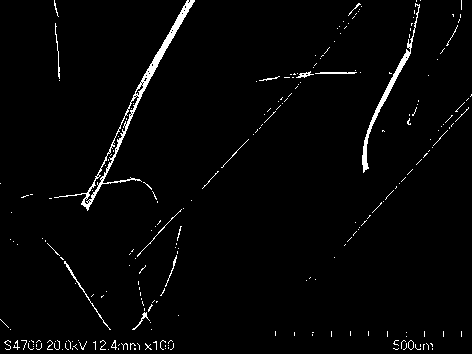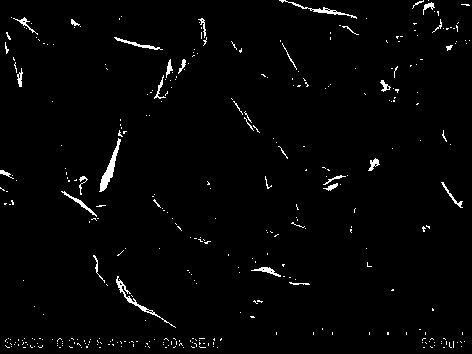Preparation method for biomass base active carbon electrode material
A technology of biomass materials and electrode materials, which is applied in the manufacture of hybrid capacitor electrodes, hybrid/electric double layer capacitors, etc., can solve the problems of limited improvement in the electrical properties of activated carbon, and achieve high power density
- Summary
- Abstract
- Description
- Claims
- Application Information
AI Technical Summary
Problems solved by technology
Method used
Image
Examples
Embodiment 1
[0029] Place the kapok fibers in deionized water at 95°C, cook for 3 h, then take out the kapok fibers, filter and dehydrate, soak in 10% hydrogen peroxide, oxidize at 80°C for 4 h, take out the oxidized kapok fibers, and wash them with deionized water Remove the oxidizing agent, filter and dehydrate. The oxidized kapok fibers were immersed in a mixed solution of ethylenediaminetetraacetic acid and KOH with a molar ratio of 1.0:4.0 for 12 h and dried at 70 °C to obtain a carbonized precursor. The carbonized precursor was placed in a tubular atmosphere furnace, and the temperature was raised to 500 °C at 5 °C / min. 2 carbonization under atmosphere, N 2 The flow rate is 200 ml / min, and the carbonization time is 2 h; the temperature of the tubular atmosphere furnace is naturally cooled, and the material is discharged and ground to obtain the carbonized product. According to the ratio of KOH to carbide weight ratio of 4.0:1.0, the carbide and KOH were mixed in deionized water, st...
Embodiment 2
[0031] Put the catkins in deionized water at 95°C, cook for 3 h, then take out the catkins, filter and dehydrate, soak in 10% hydrogen peroxide, oxidize at 80°C for 4 h, take out the oxidized catkins, wash with deionized water to remove the oxidizing agent , filtered and dehydrated. The oxidized catkins were immersed in a mixed solution of ethylenediaminetetraacetic acid and KOH with a molar ratio of 1.0:4.0, immersed for 12 h, and dried at 70 °C to obtain a carbonized precursor. The carbonized precursor was placed in a tube atmosphere furnace, and the temperature was raised to 500 °C at a rate of 5 °C / min. 2 carbonization under atmosphere, N 2 The flow rate is 200 ml / min, and the carbonization time is 2 h; the temperature of the tubular atmosphere furnace is naturally cooled, and the material is discharged and ground to obtain the carbonized product. According to the ratio of KOH to carbide weight ratio of 4.0:1.0, the carbide and KOH were mixed in deionized water, stirred ...
Embodiment 3
[0033]Put the cotton fibers in deionized water at 95°C, cook for 3 h, then take out the cotton fibers, filter and dehydrate, soak in 8% hydrogen peroxide, oxidize at 80°C for 4 h, take out the oxidized cotton fibers, and wash with deionized water Remove the oxidizing agent, filter and dehydrate. The oxidized cotton fibers were immersed in a mixed solution of ethylenediaminetetraacetic acid and NaOH with a molar ratio of 1.0:3.0, soaked for 12 h, and dried at 70 °C to obtain a carbonized precursor. The carbonized precursor was placed in a tubular atmosphere furnace, and the temperature was raised to 500 °C at 5 °C / min. 2 carbonization under atmosphere, N 2 The flow rate is 200 ml / min, and the carbonization time is 2 h; the temperature of the tubular atmosphere furnace is naturally cooled, and the material is discharged for grinding to obtain the carbonized product. According to the ratio of zinc chloride to carbide weight ratio of 5.0:1.0, the carbide and zinc chloride were m...
PUM
 Login to View More
Login to View More Abstract
Description
Claims
Application Information
 Login to View More
Login to View More - Generate Ideas
- Intellectual Property
- Life Sciences
- Materials
- Tech Scout
- Unparalleled Data Quality
- Higher Quality Content
- 60% Fewer Hallucinations
Browse by: Latest US Patents, China's latest patents, Technical Efficacy Thesaurus, Application Domain, Technology Topic, Popular Technical Reports.
© 2025 PatSnap. All rights reserved.Legal|Privacy policy|Modern Slavery Act Transparency Statement|Sitemap|About US| Contact US: help@patsnap.com



